Guitar players add vibrato to the notes they play for various reasons, but does vibrato increase sustain? In this article, I’ll reveal how vibrato can add sustain to your solos and everything else you need to know about vibrato for electric and acoustic players.
Keep on reading to learn more, but grab your favorite beverage since there’s a lot of information here.
You can use the table of contents below to take you to the area that interests you. Click on the little box to open it and then click on the section of the article you want to read, or you can read from start to finish if you want the full vibrato experience!
The Short Answer
Vibrato can increase the sustain of a note by combining it with several other pitches as the string is bent up and down. Bending the string adds kinetic energy that keeps it sounding (vibrating) for longer periods of time. The faster or wider the vibrato, the longer the note can be sustained. The sustain helps make a note with vibrato “sing” because it takes on the characteristics of the vibrato in a singer’s voice.
Keep On Reading (Below) To Learn More
What Is Vibrato?
Vibrato is a popular technique used by virtually all string instrument players, not just guitar players. It changes the pitch (frequency) of a note or chord by making it rise up and drop down.
Vibrato can be done from the forearm, wrist, fingers, and whammy (vibrato) bar. Creating sounds below the pitch of the original note requires the use of a whammy bar, which is connected to the vibrato bridge of an electric guitar.
It gives the notes a more “singing” quality that makes them sound more natural because it mimics the vibrato of a singer’s voice.
Vibrato is also used to highlight particular notes in a musical passage to build interest and excitement. For example, blues, Rock, and Metal players use vibrato to create an “edgy” sound.
How Vibrato Helps Increase Sustain
Vibrato can help increase the sustain of a note(s) because the string is rocked back and forth on the fret.
This gives the string additional kinetic energy, and various pitches are heard above and below the note that was originally played. If the pitch variations are small, the human ear hears the original note as an “ongoing” part of the guitar riff or solo.
Vibrato can be wider by bending the string above and below the original note by one to two steps or more. This can give the impression of multiple sustaining notes centered around the original tone.
Both the speed and width (depth) of the vibrato can affect a note’s sustain. Generally, faster and wider vibrato increase sustain the most because they both add additional kinetic energy to the string.
Electric Vs. Acoustic Guitar Vibrato Comparison

Here are some of the characteristics of vibrato and how they compare to electric and acoustic guitars.
| Comparison | Electric | Acoustic |
|---|---|---|
| Sustain Duration | Longer | Shorter |
| Ease Of Execution | Easier | Harder |
| Forearm Vibrato (easier than wrist and finger) | Yes | Yes |
| Wrist And Finger Vibrato | Yes | Yes |
| Whammy Bar (Vibrato Bridge) | Yes | No |
| Behind The Nut Vibrato | Yes | Yes |
| Bending The Neck Vibrato * | Yes | No |
Keep On Reading (Below) To Learn More About Each Topic
Characteristics Of Guitar Vibrato
The two main characteristics of guitar vibrato are its speed and width.
Vibrato Speed
The speed of a note’s vibrato is the number of times the pitch is raised and lowered per second. The vibrato speed will often match the song’s tempo. Faster vibratos sound more aggressive than slower ones.
Vibrato Width (Depth)
The width of a note’s vibrato is how far the note is bent up or down in pitch. Wide vibratos can bend a note 1 to 1 ½ steps or more, up and down. Wider vibratos sound more dynamic and dramatic than shallower ones.
Whammy Bar Vibrato
Using a whammy bar can give you a faster and wider vibrato than would be possible than by using your left hand on the stings. A whammy bar “divebomb” that comes back up to pitch is a type of vibrato.
Listen to David Gilmour’s playing if you want to hear a very unique use of whammy bar vibrato.
Guitar Vibrato Benefits
There are three main benefits to using vibrato.
Increased Sustain
As discussed above, vibrato can increase a note’s sustain by varying amounts. More aggressive vibrato generally gives the note more sustain.
Better Musical Expression
Vibrato can be the thing that makes a player’s style most unique. All the great guitarists have their trademark vibrato. It can sound artificial or as natural as the vibrato of a singer’s voice.
B.B. King had one of the most unique vibrato techniques I’ve ever heard. B. B. could play a single note with vibrato, and you would already know it’s him playing the guitar!

More Tonal Options
Vibrato gives you more tonal options because it allows you to bend a string to whatever pitch you want, even if it’s not a note.
Eric Clapton became famous for his quarter-step bends and vibrato in the band “cream,” and Jeff Beck is the undisputed master of micro-tonal bends and vibrato!
Vibrato Versus Tremolo
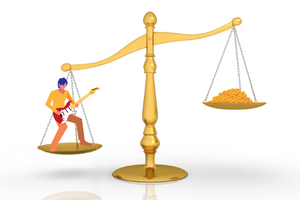
Vibrato is not the same as tremolo, although some players mistakenly use the terms interchangeably.
Vibrato changes the pitch of a note, up or down in frequency.
Tremolo changes the volume of a note, up or down in loudness.
Therefore, a “tremolo bridge and arm” is really a vibrato bridge and arm. You can call it a whammy bar if you can’t remember the difference.
You can add tremolo to a note by using the following methods.
- Twisting the pickup volume knob on your guitar down and up after plucking the note
- Using a volume pedal
- With a tremolo effect pedal
- Adjusting the speed and intensity settings on an amplifier that has built-in tremolo

Is Vibrato Better Than Tremolo?
No, not necessarily. It’s more a matter of what you need at the time, not what’s better. If it sounds better, then use it.
For example, listen to the song “For What It’s Worth” by Buffalo Springfield, and you’ll hear the brilliant use of tremolo in the opening riff. In my opinion, vibrato wouldn’t have sounded anywhere as good!
Vibrato and tremolo are distinctly different effects and can be used separately or combined to give your playing a variety of sounds.
Types Of Guitar Vibrato
Rock, Blues, and Metal players commonly use left-hand or whammy bar vibrato. Here are the techniques that electric and acoustic players have used.
Common Techniques
Forearm Vibrato
To get the fastest, widest, and most consistent vibrato, rotate your left forearm to get the vibrato effect instead of trying to use your wrist and fingers.
This is the method most commonly used by electric guitar players.
Then, there’s Eric Clapton’s vibrato method. He doesn’t rotate his forearm. Instead, he bends the strings by moving (not rotating) his left arm so that his fingers push the string up and let it come back down.
This gives you that unique “Clapton Sound.” Eric is such a master of the guitar that I highly recommend you try it! Watch any of his music videos, and he clearly demonstrates it.

Wrist And Finger Vibrato
Some players keep their left forearm still and move their wrists back and forth to get their vibrato. I’ve also seen players keep their left wrist still and bend the strings by moving their fingers.
Although these methods can work with some classical guitar techniques, I don’t recommend them for electric players because it’s much more difficult, and your vibrato generally will be less prominent with this method.
Whammy Bar (Bridge) Vibrato
A vibrato bridge comes installed on some electric guitars. It allows a player to bend the strings of a guitar with the right hand by using a whammy (vibrato) bar.
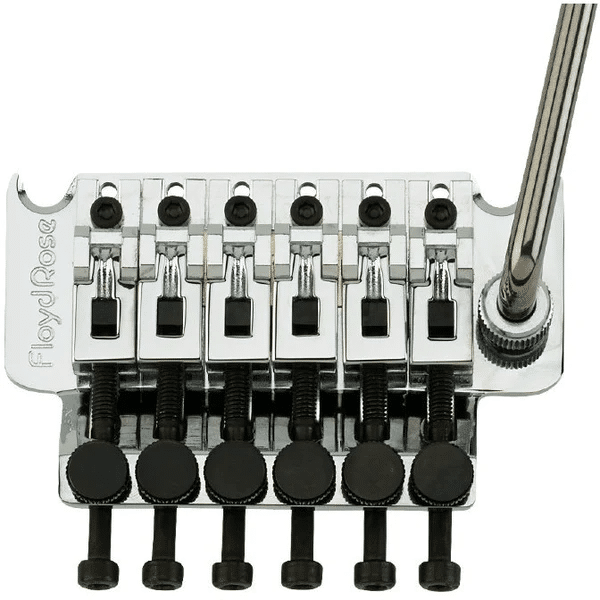
You can get different vibrato effects depending on how the bridge is set up.
A floating vibrato bridge allows the bar to be moved in both directions so that the pitch of the strings can be brought up or down.
A decked vibrato bridge only allows the pitch of the strings to be lowered because the bridge sits flush against the guitar’s body so that the whammy bar can’t be pulled up from the resting position.
Related Article ➡ Floating Vs Decked Vs Blocked Tremolo Bridge – 3 Great Setups!
Uncommon Techniques
Behind The Nut
It’s possible to raise the pitch of a note by bending a guitar string behind the nut. This type of vibrato is sometimes performed by players that want to bend an open string but don’t have a whammy bar.
One of the most famous songs that use this technique is “Dazed And Confused” by Led Zeppelin. Jimmy page bends the open note behind the nut of his 1959 Les Paul and gets a spectacular-sounding vibrato effect!

Bending The Neck
Some electric players get a vibrato effect by bending the neck of their guitar by holding the guitar’s body with their right hand and pushing the neck forward or pulling it backward with their left hand.
Never try this on an acoustic guitar. For more info, see the warning below.
Combining Note Bending With Vibrato
Bending a guitar string up with the left hand and holding it at that pitch while adding vibrato can be one of the most challenging techniques to master, especially if you have small hands.
This is because you are adding vibrato to a string under more tension than one that has not been bent up.
Greg Koch is one of the masters of the “bend and add vibrato” technique! In addition to his own savory brand of bent vibrato, you can hear him emulate the methods of such greats as B. B. King, Albert King, Freddie King (none of whom are related), Eric Clapton, and the list goes on and on!

This technique is definitely worth mastering because it can be used to create some of the most exciting sounds in guitar riffs and solos!
Take your time and get good at bending strings with your left hand up to the correct pitch before you try to master this technique. Next, add vibrato to a bent note to raise and lower its pitch. Don’t cheat by using a whammy bar!
How To Make Bending Notes And Vibrato Easier

Here are some things you can do to make bending notes easier, especially if you add vibrato to a bent note.
Get A Decent Guitar
You don’t have to spend a fortune on a starter guitar, but learning on a crappy used or hand-me-down guitar can be a difficult and discouraging experience. Strings that are too difficult to press down on the frets will be twice as hard to bend or perform vibrato!
Bend Using Your Forearm
Bending strings and adding vibrato is easier and sounds better if you rotate your forearm and keep your wrist and fingers still. This is because using the muscles in your forearm gives you more power.
Beginners who use their wrists and fingers often have difficulty making any progress with vibrato.
Bend Notes Higher Up The Neck
You’ll find it a lot more difficult if you try to learn to bend notes or add vibrato to strings that are too close to the nut or where the neck meets the guitar’s body.
When you’re beginning, perform these techniques at or around the twelfth fret, where the strings are easier to bend.
Use Lighter Gauge Strings
Lighter gauge strings will tune up to pitch at a lower tension than thicker ones. The trade-off is a loss of tone and sustain, so if the string gauge is too thin, you might not like the way your guitar sounds.
I recommend starting with a set of 0.009 to 0.042 gauge strings for electric players. These will give you good bendability and a decent tone. Acoustic players can start with a light gauge set of metal strings. Use standard gauge nylon strings if you have a classical guitar.
However, be aware that if you change the gauge of your strings, your guitar may need a setup to play and sound right.
Practice On An Acoustic Guitar
If you’re having trouble bending strings or performing vibrato on your electric guitar, playing an acoustic instrument will strengthen the muscles of your left forearm, hand, and fingers. You’ll be amazed at how easy it will be when you go back to playing your electric guitar!
You can also try hand “squeeze devices” to strengthen these muscles.
Adjust The String Action
Strings that are too high or too low can be difficult to bend and do vibrato. Adjust the action (string height), so you can easily press them down using the middle of your fingertips.
Get A Guitar Setup
Getting your guitar correctly set up will allow you to have a lower action without string buzzing and make your instrument easier to play.
Use A Guitar With A Shorter Scale Neck
Guitars with shorter scale necks have lower string tension, which can make the strings easier to bend and do vibrato.
Fender necks typically have a 25.5-inch scale length, which tends to be longer than the Gibson necks, which are mostly 24.75 inches, but there are some exceptions. For example, Fender Mustang scale lengths can be as short as 24 inches, depending on the actual model.
Shorter scale length guitars also have frets that are closer together, which means less finger stretching.
Get A Guitar With A Flatter Fretboard And Bigger Frets
Some of the newer electric guitars have a flatter fingerboard radius (12 to 15 inches) and larger (wider and taller) frets, especially those designed to play Metal. This makes it easier to bend strings and do vibrato because it reduces the friction between the fingertips and the fretboard.
The vintage Fender guitars with curved (7.25 inch) fretboards and lower frets can be a lot more challenging to play, especially if you’re a lead guitar player that does lots of bends and vibrato.
Find The Right Neck Shape, Material, And Finish
Guitar necks come in several shapes, such as “C,” “D,” or “V-shaped.”
Fretborad materials and finishes can vary from one guitar to the other. For example, rosewood and ebony fretboards are not finished, while maple fretboards can have a dull or glossy polyurethane vs. nitrocellulose finish.
Find the guitar neck that feels best in your hand and plays best, especially with string bending and vibrato.
Use A Whammy Bar
A whammy bar on a guitar with a vibrato bridge can be used to raise or lower the pitch of a note and perform vibrato. Whammy bar bends and vibrato will sound different than the same techniques performed with the left hand. Some players use a combination of both methods, depending on the sound they need.
Does The Guitar Affect Vibrato?
Yes, the guitar you play can affect vibrato, even if it doesn’t have a vibrato bridge (whammy bar)!
Here are some of the things on a guitar that can affect the execution and sound of vibrato.
- The nut
- Neck shape, material, and fretboard radius
- Neck scale length
- Fret size and material
- Neck joint
- Guitar body size, thickness, and material
- Pickups and and electronics
- Bridge, saddles, and type (fixed vs. whammy bar)
- Age of the instrument
You may have to adjust your vibrato technique to accommodate each instrument if you have two or more guitars. Even two guitars of the same make, model, and year of manufacture can play and sound differently!
Guitars That Have A Vibrato Bridge

Here are some of the guitars I like that have a vibrato bridge (whammy bar).
Standard Vibrato Bridge Guitars
These guitars have a vibrato bridge that does not lock the strings. They’re fine for all-purpose use, but if you really use your whammy bar for big string bends and vibrato, consider getting a guitar with a double-locking vibrato bridge to keep it in tune, like the ones listed below.
Squier by Fender: Affinity Series Stratocaster
Check out this guitar if you’re looking for a very affordable Strat with a 60s vibe. Squiers play great, and when I put this guitar through its paces, it’s no exception. Although it’s Fender’s lower-end guitar, I’ve seen them used by pros!
The 2-point vibrato bridge stays in tune pretty well for a non-locking tremolo system. I really like the slim “C”-shape neck, and the poplar body is relatively lightweight. The maple neck has an Indian laurel 9.5″ radius fingerboard, making it easy to bend notes and vibrato.
It comes in 3-Color Sunburst, Olympic White, Black, and Lake Placid Blue. You won’t find a better playing guitar for the money!

Click HERE To Check Reviews & Price On Amazon
PRS S2 Custom 24
If you want to spend more and get a gorgeous axe, check out the PRS S2 Custom 24 (pictured here in Eriza Verde). It sounds fabulous and has a synthetic nut and locking tuners that keep it in tune remarkably well, even with aggressive whammy bar vibrato!
I own five PRS guitars, three with a vibrato bridge. I find the whammy bar action very smooth and precise. It’s the best non-locking vibrato bridge on the market.
I love the sound and clarity of the 85/15 “S” pickups! The thin-carve mahogany 10″ radius neck feels great and makes vibrato and string bends a joyful experience. It has a beautiful rosewood fingerboard with the PRS classic bird inlays.

Click HERE To Check Reviews & Price On Amazon
Double Locking Vibrato Bridge Guitars
These vibrato bridges lock the strings at the bridge and the nut, so the guitar stays in tune, even with the most aggressive whammy bar use.
Fender Player Stratocaster Floyd Rose HSS
Fender makes a fine example of a Strat with a Floyd Rose double-locking tremolo system.
It has an alder body with Player Series Pickups, one humbucker in the bridge position, and a single-coil in the middle and neck position. These pickups have a bit more bit than the standard Strat version.
I love the feel and playability of the modern “C”-shaped maple neck. The 12-inch fingerboard radius makes vibrato and string bending a breeze!
If you want a well-priced Strat that is perfect for Rock and Metal, give this axe a look! It comes in Tidepool, Polar White, and 3-Color Sunburst.

Click HERE To Check Reviews & Price On Amazon
ESP LTD Alexi Ripped Electric Guitar – Purple Fade Satin
Ok, if you’re looking for a real shed machine, check out the ESP LTD Alexi Ripped guitar with an offset-v shape and “ripped” pinstripes! This Alexi Laiho Signature model sounds and plays as awesome as it looks in Purple Fade Satan!
The alder body looks absolutely wicked and feels comfortable to hold. One of the best parts of this guitar is the 3-piece, thin “U”-shaped maple neck. It has a 24-fret ebony fingerboard, and best of all, it’s scalloped from frets 19–24!
The scalloping makes bending and vibrato easy, even when blazing through the fastest notes!
It has a passive EMG Hz F-H2 humbucking bridge pickup, and a passive EMG Hz S2 slanted stacked single-coil pickup in the neck position. I can tell you that they both deliver heavy metal mayhem sounds in spades!
The Double-locking Floyd Rose 1000 tremolo will put you in “divebomb and vibrato heaven.”
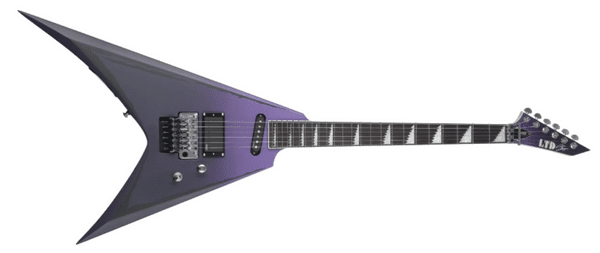
Click HERE To Check Reviews & Price On Amazon
Can You Add A Vibrato Bridge To A Guitar?
Yes, changing a fixed bridge over to a whammy bar is possible, but it’s usually not worth the trouble or cost! Your best bet is to get a second guitar with the kind of vibrato bridge you’re looking for, standard or locking.
A better option is to convert one type of vibrato bridge to another. For example, here is a 1970 Stratocaster that I modified to change the traditional vibrato bridge to a Kahler double-locking system.
The idea was to make it a full-on metal guitar, so I changed the pickups to Seymour Duncan Hot Rails with a mini toggle switch that allows the selection of the neck and bridge pickups or all three pickups together.
I also changed the neck to a Phil Kubicki 15-inch radius fretboard with an ebony fingerboard and Dunlop jumbo frets.
The buzzard eating the skull’s eyeball gives it that special Metal touch, or is it a vulture? I can never tell! ?
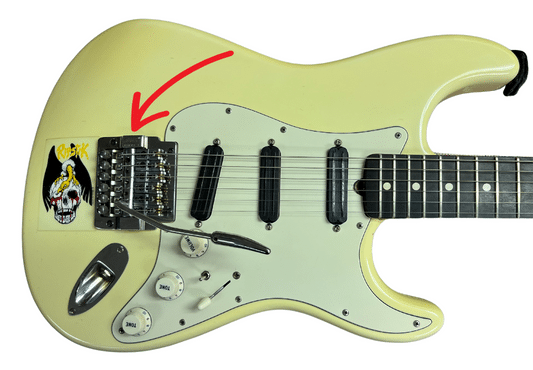
To install the vibrato bridge, I had to permanently modify the vibrato cavity by routing space for the springs that operate the rotating cam system, as seen below.
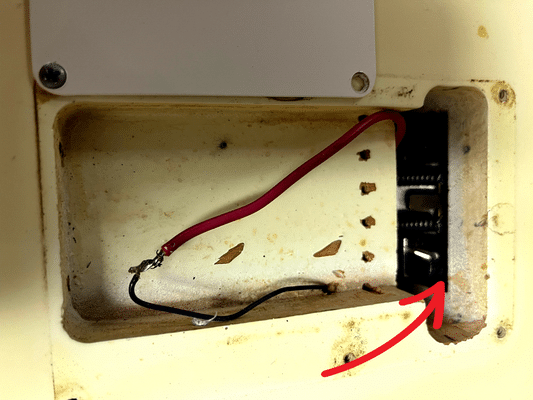
The front and rear mods are all permanent, although I could reinstall the original vibrato bridge or change it to a Floyd Rose double-locking system.
These types of modifications require special tools and training. Do not attempt them, or you could risk permanently damaging your guitar! Take your instrument to a luthier or certified guitar tech for the best results!
Guitar Masters Of Vibrato
Here are some of the undisputed masters of various types of vibrato on the electric and acoustic guitar. Of course, there are many others, but this article is already too long. Enjoy!
Electric Guitar
The artists in this section are divided into those that get their vibrato from fixed bridge, standard vibrato bridge, and double-locking vibrato bridge guitars.
Angus Young (Fixed Bridge Guitar)
Angus, the lead guitar player for the band AC/DC, has the best vibrato on a fixed bridge guitar that I’ve ever heard! It’s so fast and tight that it sends a shiver down my spine! Of course, his weapon of choice is the Gibson SG guitar.
You can see his guitar neck shake when this little guy does his vibrato!

He doesn’t use any effects pedals or other gadgets. He gets all his sound from his fingers, guitar, and a wall of Marshall stacks.
When I first saw him on MTV in the 1970s, I started laughing at his “schoolboy” suit, complete with a book backpack. When he started playing, my eyeballs fell out of my head; I couldn’t believe how great he sounded! Sorry about that, Angus!
Jeff Beck (Standard Vibrato Bridge Guitar)
Jeff was (and still is) the undisputed master of the non-locking whammy bar! What Jeff could do with the whammy bar, left-hand vibrato, and guitar slide is beyond amazing! The way he played micro-tones and harmonics while combining vibrato and adjusting the guitar’s volume and tone controls is simply mind-boggling!
Jeff was always a fabulous player, but when he ditched his guitar pick and developed his unique fingerpicking technique, things got really interesting!
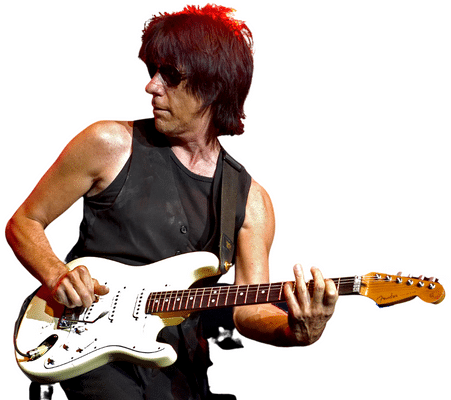
To quote Eric Clapton, Jeff’s string bending and vibrato technique sound like “he is pulling the sound!” Jeff’s recent death was like an arrow through my heart!
Jeff Beck – accept no substitutes (and there will never be any)!
Steve Vai (Double-Locking Vibrato Bridge Guitar)
Like Joe Satriani, his former guitar teacher, Steve Vai does incredible things with a double-locking vibrato bridge! Steve does tricks with the whammy bar and left-hand vibrato like someone that escaped from Area 51!
The first time I saw Steve play live was at a Frank Zappa concert in Rome, Italy, in the 70s, and I was awe-struck at the sounds coming from his “pre-Ibanez” Strat!
Check out the movie “Crossroads,” with Ralph Macchio (the “wax on, wax off” guy). That’s Steve Vai playing the part of the devil’s guitarist in the “head cutting” contest!

Steve has two Ibanez signature guitars (the JEM and PIA), both of which have vibrato bridges designed to give him an enhanced ability to stretch the strings, providing him with the widest possible vibrato.
Acoustic Guitar
Here are two acoustic guitar players playing Classical and Flamenco styles. Their vibrato comes from a combination of their left forearm, hand, and fingers.
Andres Segovia (Fixed Bridge Guitar)
Andre Segovia is widely known as the father of the classical guitar! He gave it a legitimate place in Classical music by rearranging pieces for the instrument. His other works include music from the modern-romantic and baroque styles.
Andre brought several essential left-hand vibrato techniques to the classical guitar that also can be used on an electric instrument.

I was fortunate enough to attend a seminar given by Andre at the University Of Siena Music Conservatory, which was nothing less than astonishing!
Paco De Lucia (Fixed Bridge Guitar)
Paco De Lucia is one of the guitar players that influenced me most in the Flamenco style. His interpretation of the “New Flamenco Style” combined elements of Flamenco with Classical and Jazz!
Paco’s energetic vibrato style complimented his fast and fluent fingerstyle runs. He received an honorary doctorate from the Berklee College of Music In 2010.

I first heard Paco on a recording called “Passion, Grace, and Fire” with Al Di Meola and John McLaughlin. His playing set his unique style apart from the other two guitarists, and I followed Paco’s work for the remainder of his career.
I love the way he used Flamenco percussive effects to compliment his playing!
“Bending The Neck” Guitar Vibrato Is Risky!

Some electric players get vibrato by actually bending the neck of their guitar. They hold the body with their right hand and push the neck forward or pull it backward with their left hand.
This is not a vibrato technique I recommend. It is very dangerous because it can loosen the neck joint or break it where it attaches to the body, especially if it is glued in!This should never be attempted on any type of acoustic guitar!
I’ve seen more damaged guitars than you can imagine done by players who insist on using this vibrato technique. Unfortunately, the repair can exceed the actual value of the instrument!
Are You Qualified To Make Guitar Adjustments Or Modifications?
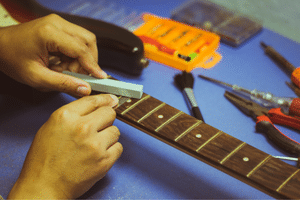
It’s great to work on your guitars, especially if you have a lot of them, but you should always be aware of your limitations.
Adjusting things like an electric guitar’s string height (action) or pickup height can be straightforward. Still, some adjustments require the proper training and experience, like adjusting a guitar’s truss rod.
If you decide to replace the bridge of your guitar to get vibrato from a whammy bar, I highly recommend you carefully consider the outcome.
When you doubt your ability to adjust, repair, or modify your guitar, it’s always best to bring it to a competent guitar technician or luthier (guitar designer & builder). You can permanently damage your guitar, and it might never play and sound right again!
Making modifications to your guitar can void its manufacturer’s warranty and cause permanent damage to the instrument. Certain modifications are irreversible, so you may be stuck with them, even if you desperately want to restore the guitar to its original condition!
I learned that the hard way over the years until I did a three-year apprenticeship in a guitar repair shop. Now I have my own home workshop with the proper training and equipment to safely maintain and repair all my instruments.
Remember: “When In Doubt, Send It Out!”
Frequently Asked Questions

Here are some of the questions I get asked about guitar vibrato.
If your question does not appear here, please put it in the comments, and I will get right back to you with an answer.
What Is The Purpose Of Guitar Vibrato?
Vibrato makes the note you play “sing,” like the vibrato in a singer’s voice. This makes it sound more natural with a human quality. Guitar vibrato can also make a guitar riff or solo more dynamic if used sparingly because it highlights specific notes.
How Do You Know Of You Are Doing Vibrato Correctly?
Although there are standard ways to perform vibrato, there’s actually no “right way” to use it. Let your ears and the opinions of others be your guide. Guitar vibrato is a very personal thing and can help define a player’s style.
Can You Use Vibrato Too Much?
Yes, it is possible to overuse vibrato. It works best when used sparingly to add interest and excitement to musical passages. Vibrato will make a melody or solo sound artificial if you use it too frequently or on every note.
Can I learn Vibrato In A Week?
You can learn the basics of vibrato in one week, but guitar vibrato can take years to master. So keep working on vibrato and try to make it unique to your playing style!
Does Vibrato Change The Note?
Yes, vibrato can change the pitch of a note, especially if the note is raised or lowered before the vibrato is applied. If vibrato is done with the pitch of the original note in the center, the audience may perceive it as more natural sounding.
Is It Better To Have Fast Or Slow Vibrato?
One vibrato speed is not clearly better than another. The speed and width of the vibrato should fit with what’s happening in the song. A slow musical passage may require a slow vibrato and vice versa. However, it’s always best to think creatively when using vibrato and select the speed that feels right.
Final Thoughts

I hope you found this article on does vibrato increase sustain helpful! Guitar vibrato is a technique that can help you sustain notes longer and easily set you apart as a unique player. It makes a note “sing” because it takes on the vibrato characteristics in a singer’s voice.
Although the basics of vibrato can be learned very quickly, it is a technique that can take years to master!
Vibrato can vary in both speed and width (depth). Using a whammy bar can help increase vibrato speed and depth. In addition, vibrato can increase tonal options by allowing you to add pitches of less than ½ tone (micro-tones) into your playing.
Various types of vibrato can be performed on electric and acoustic guitars. Each type has its own expressive characteristics. Note bending can be combined with vibrato for maximal effect. You can do several things to make learning and performing vibrato easier.
The guitar you use can affect the sound of the string vibrato.
Related Article ➡ Does Your Guitar Affect Vibrato Playing? – Make Solos Soar!

Here’s a great video from Fender that sounds you how to do various types of vibrato and how it can enhance the sustain of the notes you play. Check it out!
Tell Me What You Think

Please leave a comment below if you enjoyed this article, have any questions about vibrato and sustain, or want to give your point of view. I will be happy to help you.
- What vibrato method do you like best?
- Do you perform vibrato with your left hand, a whammy bar, or both?
- Which famous guitar player has the best vibrato?
- After reading this article, are you thinking of learning how to do vibrato?
- What else is on your mind?



Wow what a great article! Ive heard of vibrato used in singing but I didn’t realize that it is also used in string instruments, mostly guitars. Playing the guitar has always amazed me and it blows my mind how great people are at playing it. Your article has inspired me to try to learn guitar someday.
Hi, Yonson
Thank You for your comments!
Yes, all string instruments use vibrato as an indispensable technique for tonal expression.
There’s no time like the present to begin learning to play the guitar! The hardest step is to take the first step by getting yourself an instrument.
These days, there are so many instructional methods that anyone can learn to play.
Frank 😎🎸
Hey there! Just wanted to drop a comment and say that I really enjoyed reading your article on vibrato and its impact on sustain. I’ve been playing guitar for a while now and I’m always looking to improve my technique, so this topic was right up my alley!
I have to say, I have definitely noticed a difference in sustain when using vibrato. It’s amazing how such a small movement can have such a big impact on the overall sound of the note. I find that vibrato really helps bring out the character and emotion in a note, which is something I strive for in my playing.
Thanks for sharing this information and for offering up some tips on how to improve vibrato technique. It’s articles like these that help us guitar players continue to grow and develop our skills. Keep up the great work!
Hi, Bob
Thank You for your comments!
I’m thrilled that you found this article helpful!
Learning the various types of vibrato for electric and acoustic guitar is a never-ending process. It really does help define who we are as guitar players.
As you say, it can significantly change the feel and emotion of anything we play. The sustain vibrato can add to a note can substantially benefit the player and listener because of its emphasis on a musical statement!
Keep on Rocking!
Frank